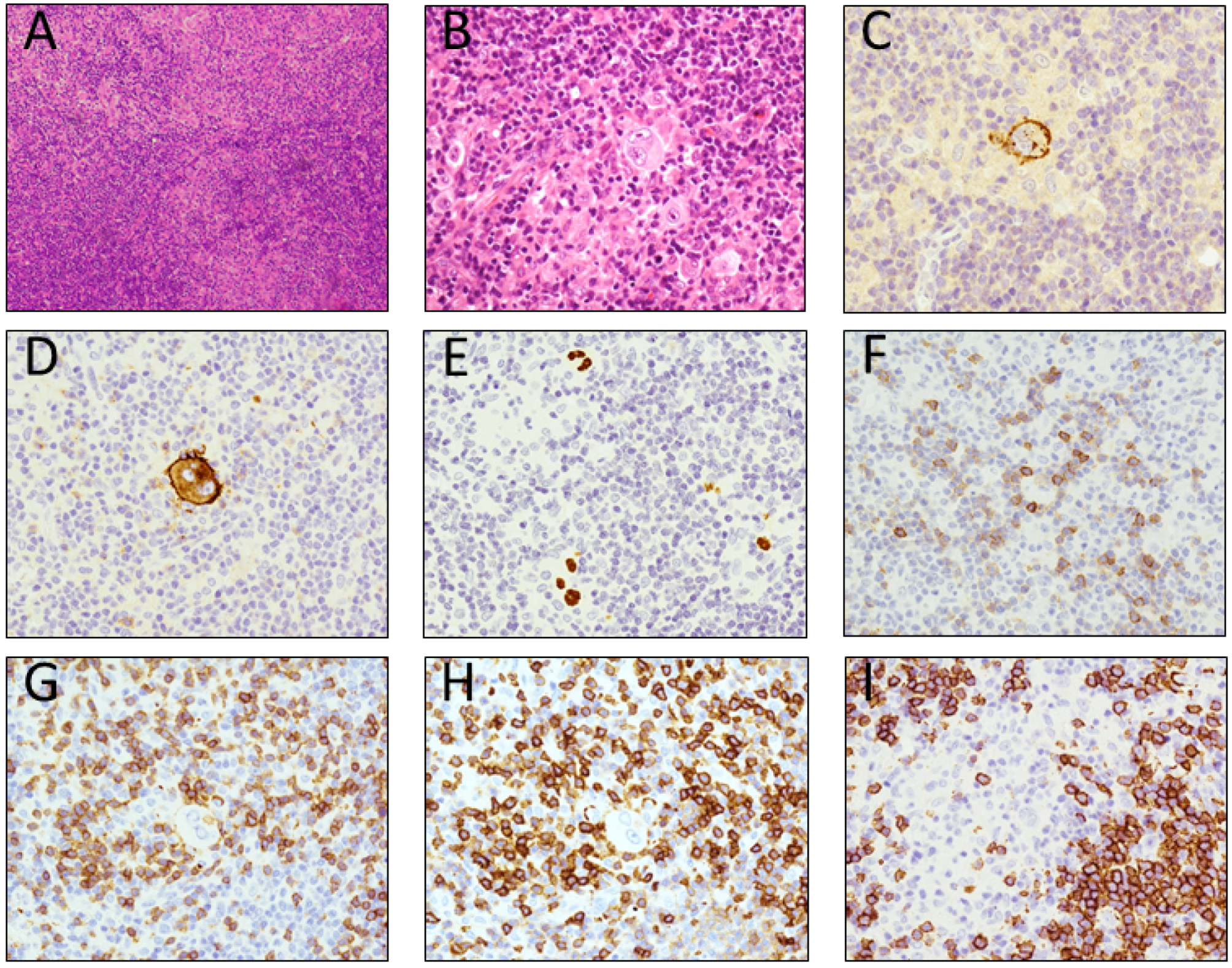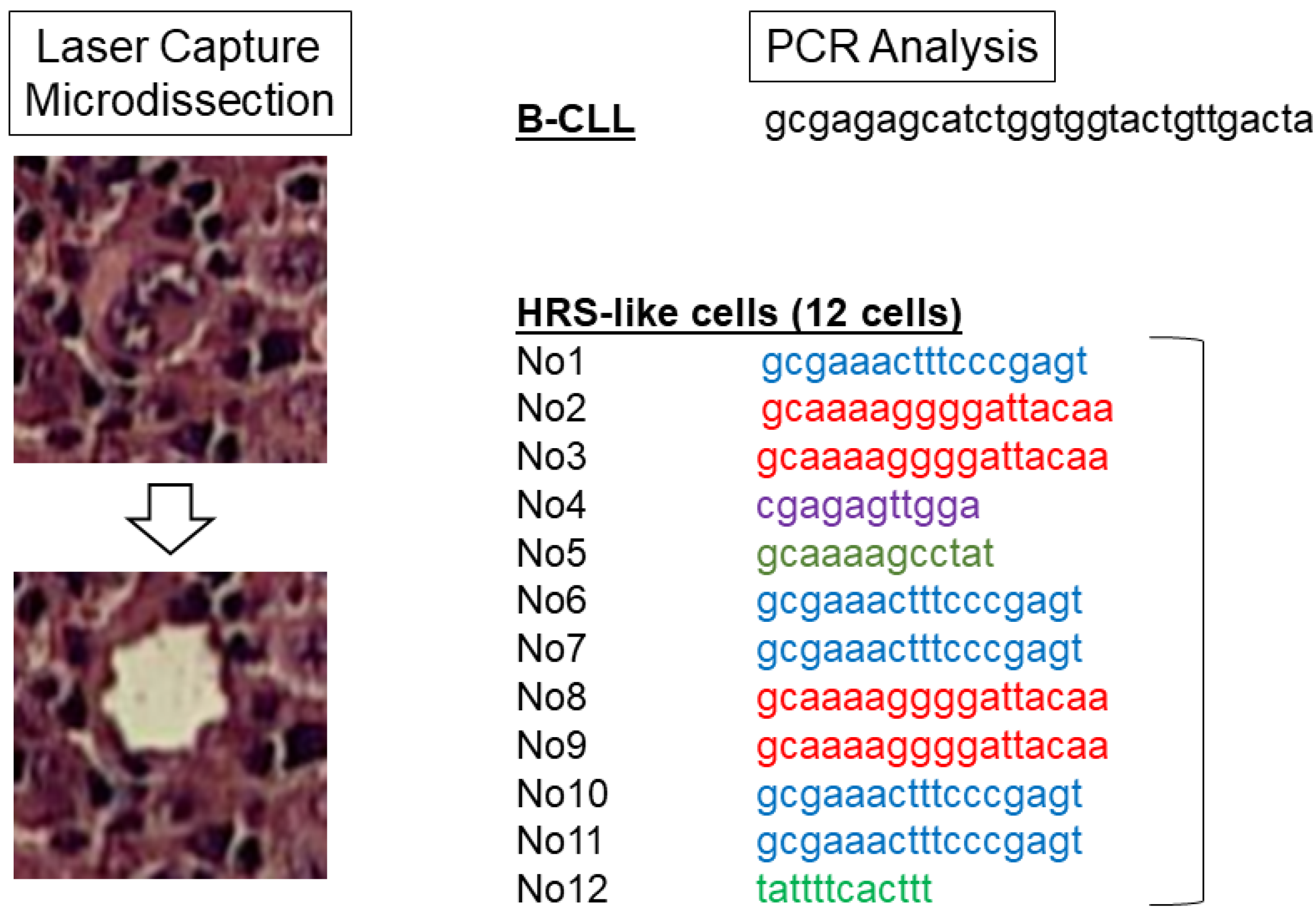Classic Hodgkin Lymphoproliferative Diseases Clonally Unrelated to B-Chronic Lymphocytic Leukemia Successfully Treated with Bendamustine Plus Rituximab
Abstract
1. Introduction
2. Materials and Methods
3. Case Presentation
4. Discussion
5. Conclusions
Author Contributions
Funding
Acknowledgments
Conflicts of Interest
References
- Swerdlow, S.H.; Campo, E.; Pileri, S.A.; Harris, N.L.; Stein, H.; Siebert, R.; Advani, R.; Ghielmini, M.; Salles, G.A.; Zelenetz, A.D.; et al. The 2016 revision of the World Health Organization classification of lymphoid neoplasms. Blood 2016, 127, 2375–2390. [Google Scholar] [CrossRef] [PubMed]
- Ichikawa, A.; Arakawa, F.; Kiyasu, J.; Sato, K.; Miyoshi, H.; Niino, D.; Kimura, Y.; Takeuchi, M.; Yoshida, M.; Ishibashi, Y.; et al. Methotrexate/iatrogenic lymphoproliferative disorders in rheumatoid arthritis: Histology, Epstein-Barr virus, and clonality are important predictors of disease progression and regression. Eur. J. Haematol. 2013, 91, 20–28. [Google Scholar] [CrossRef] [PubMed]
- Kanzler, H.; Küppers, R.; Helmes, S.; Wacker, H.H.; Chott, A.; Hansmann, M.L.; Rajewsky, K. Hodgkin and Reed-Sternberg-like cells in B-cell chronic lymphocytic leukemia represent the outgrowth of single germinal-center B-cell-derived clones: Potential precursors of Hodgkin and Reed-Sternberg cells in Hodgkin’s disease. Blood 2000, 95, 1023–1031. [Google Scholar] [PubMed]
- Xiao, W.; Chen, W.W.; Sorbara, L.; Davies-Hill, T.; Pittaluga, S.; Raffeld, M.; Jaffe, E.S. Hodgkin lymphoma variant of Richter transformation: Morphology, Epstein-Barr virus status, clonality, and survival analysis-with comparison to Hodgkin-like lesion. Hum. Pathol. 2016, 55, 108–116. [Google Scholar] [CrossRef] [PubMed]
- Tsimberidou, A.M.; O’Brien, S.; Kantarjian, H.M.; Koller, C.; Hagemeister, F.B.; Fayad, L.; Lerner, S.; Bueso-Ramos, C.E.; Keating, M.J. Hodgkin transformation of chronic lymphocytic leukemia: The M. D. Anderson Cancer Center experience. Cancer 2006, 107, 1294–1302. [Google Scholar] [CrossRef] [PubMed]
- Bockorny, B.; Codreanu, I.; Dasanu, C.A. Hodgkin lymphoma as Richter transformation in chronic lymphocytic leukaemia: A retrospective analysis of world literature. Br. J. Haematol. 2012, 156, 50–66. [Google Scholar] [CrossRef] [PubMed]
- Marafioti, T.; Hummel, M.; Foss, H.D.; Laumen, H.; Korbjuhn, P.; Anagnostopoulos, I.; Lammert, H.; Demel, G.; Theil, J.; Wirth, T.; et al. Hodgkin and reed-sternberg cells represent an expansion of a single clone originating from a germinal center B-cell with functional immunoglobulin gene rearrangements but defective immunoglobulin transcription. Blood 2000, 95, 1443–1450. [Google Scholar] [PubMed]
- Abruzzo, L.V.; Rosales, C.M.; Medeiros, L.J.; Vega, F.; Luthra, R.; Manning, J.T.; Keating, M.J.; Jones, D. Epstein-Barr virus-positive B-cell lymphoproliferative disorders arising in immunodeficient patients previously treated with fludarabine for low-grade B-cell neoplasms. Am. J. Surg. Pathol. 2002, 26, 630–636. [Google Scholar] [CrossRef] [PubMed]
- Tadmor, T.; Liphshitz, I.; Silverman, B.; Polliack, A. Incidence and epidemiology of non-Hodgkin lymphoma and risk of second malignancy among 22466 survivors in Israel with 30 years of follow-up. Hematol. Oncol. 2017, 35, 599–607. [Google Scholar] [CrossRef] [PubMed]
- Pina-Oviedo, S.; Miranda, R.N.; Medeiros, L.J. Cancer Therapy-associated Lymphoproliferative Disorders: An Under-recognized Type of Immunodeficiency-associated Lymphoproliferative Disorder. Am. J. Surg. Pathol. 2018, 42, 116–129. [Google Scholar] [CrossRef] [PubMed]
- Cutucache, C.E. Tumor-induced host immunosuppression: Special focus on CLL. Int. Immunopharmacol. 2013, 17, 35–41. [Google Scholar] [CrossRef] [PubMed]
- Shabani, M.; Nichols, K.E.; Rezaei, N. Primary immunodeficiencies associated with EBV-Induced lymphoproliferative disorders. Crit. Rev. Oncol. Hematol. 2016, 108, 109–127. [Google Scholar] [CrossRef] [PubMed]
- Koens, L.; Senff, N.J.; Vermeer, M.H.; Willemze, R.; Jansen, P.M. Methotrexate-associated B-cell lymphoproliferative disorders presenting in the skin: A clinicopathologic and immunophenotypical study of 10 cases. Am. J. Surg. Pathol. 2014, 38, 999–1006. [Google Scholar] [CrossRef] [PubMed]
- Howell, M.; Gibb, A.; Radford, J.; Linton, K. Bendamustine can be a bridge to allogeneic transplantation in relapsed Hodgkin lymphoma refractory to brentuximab vedotin. Br. J. Haematol. 2017, 179, 841–843. [Google Scholar] [CrossRef] [PubMed]
- Corazzelli, G.; Angrilli, F.; D’Arco, A.; Ferrara, F.; Musto, P.; Guarini, A.; Cox, M.C.; Stelitano, C.; Storti, S.; Iannitto, E.; et al. Efficacy and safety of bendamustine for the treatment of patients with recurring Hodgkin lymphoma. Br. J. Haematol. 2013, 160, 207–215. [Google Scholar] [CrossRef] [PubMed]
- Moskowitz, A.J.; Hamlin, P.A.; Perales, M.A.; Gerecitano, J.; Horwitz, S.M.; Matasar, M.J.; Noy, A.; Palomba, M.L.; Portlock, C.S.; Straus, D.J.; et al. Phase II study of bendamustine in relapsed and refractory Hodgkin lymphoma. J. Clin. Oncol. 2013, 31, 456–460. [Google Scholar] [CrossRef] [PubMed]


© 2018 by the authors. Licensee MDPI, Basel, Switzerland. This article is an open access article distributed under the terms and conditions of the Creative Commons Attribution (CC BY) license (http://creativecommons.org/licenses/by/4.0/).
Share and Cite
Rai, S.; Tanaka, H.; Fujimoto, K.; Kumode, T.; Inoue, H.; Taniguchi, Y.; Morita, Y.; Espinoza, J.L.; Tatsumi, Y.; Ashida, T.; et al. Classic Hodgkin Lymphoproliferative Diseases Clonally Unrelated to B-Chronic Lymphocytic Leukemia Successfully Treated with Bendamustine Plus Rituximab. Cancers 2018, 10, 304. https://doi.org/10.3390/cancers10090304
Rai S, Tanaka H, Fujimoto K, Kumode T, Inoue H, Taniguchi Y, Morita Y, Espinoza JL, Tatsumi Y, Ashida T, et al. Classic Hodgkin Lymphoproliferative Diseases Clonally Unrelated to B-Chronic Lymphocytic Leukemia Successfully Treated with Bendamustine Plus Rituximab. Cancers. 2018; 10(9):304. https://doi.org/10.3390/cancers10090304
Chicago/Turabian StyleRai, Shinya, Hirokazu Tanaka, Ko Fujimoto, Takahiro Kumode, Hiroaki Inoue, Yasuhiro Taniguchi, Yasuyoshi Morita, J. Luis Espinoza, Yoichi Tatsumi, Takashi Ashida, and et al. 2018. "Classic Hodgkin Lymphoproliferative Diseases Clonally Unrelated to B-Chronic Lymphocytic Leukemia Successfully Treated with Bendamustine Plus Rituximab" Cancers 10, no. 9: 304. https://doi.org/10.3390/cancers10090304
APA StyleRai, S., Tanaka, H., Fujimoto, K., Kumode, T., Inoue, H., Taniguchi, Y., Morita, Y., Espinoza, J. L., Tatsumi, Y., Ashida, T., Matsuoka, R., Kikuti, Y. Y., Nakamura, N., & Matsumura, I. (2018). Classic Hodgkin Lymphoproliferative Diseases Clonally Unrelated to B-Chronic Lymphocytic Leukemia Successfully Treated with Bendamustine Plus Rituximab. Cancers, 10(9), 304. https://doi.org/10.3390/cancers10090304




